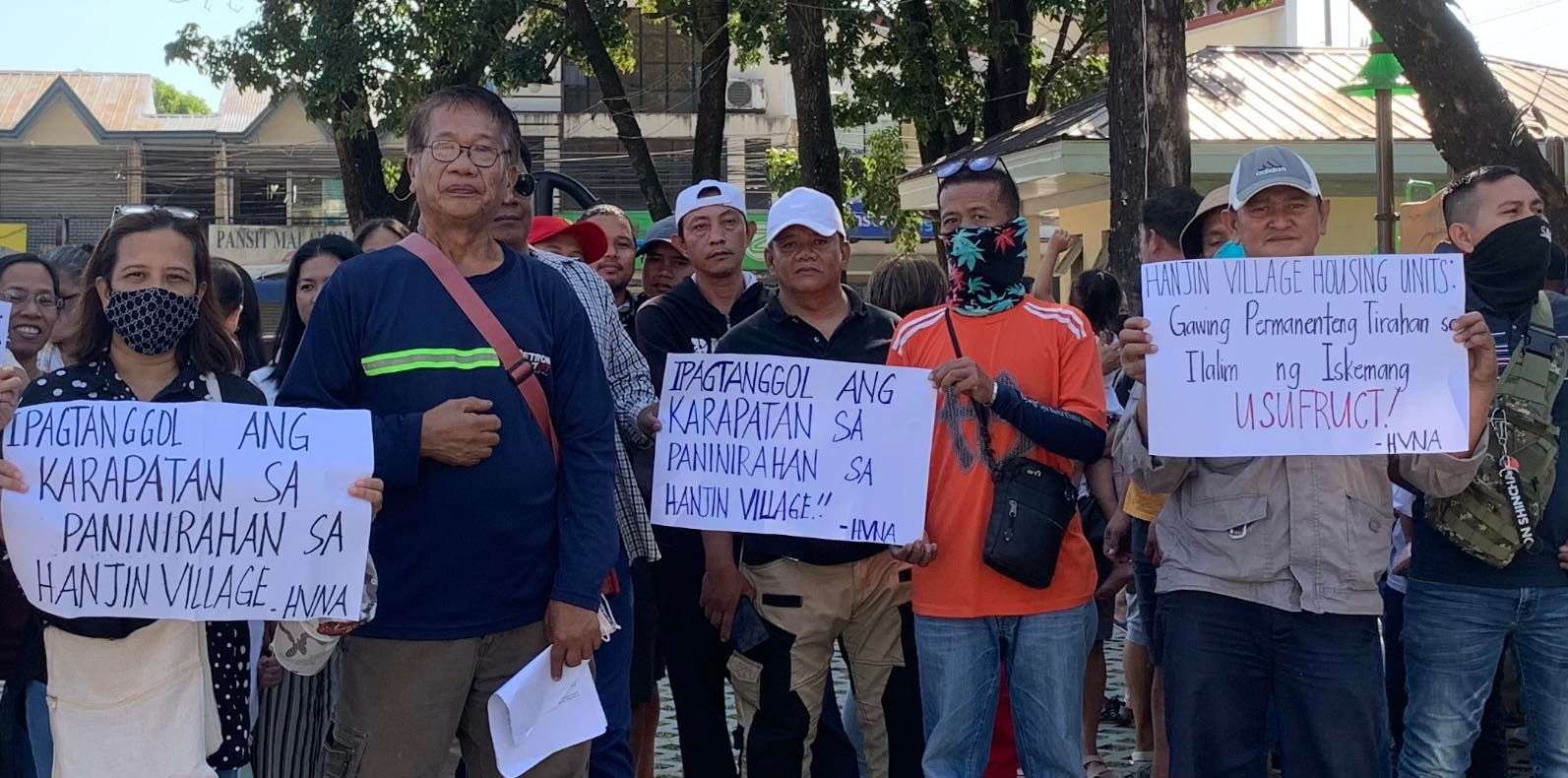Displaced Hanjin workers fight eviction from housing village in Zambales town

Former workers of Hanjin shipyard in Zambales province stage a protest in this photo taken on Monday (March 6) after they were evicted from the housing village built for them by the cash-strapped South Korean Hanjin shipping firm. (Photo by Joanna Rose Aglibot)
CASTILLEJOS, Zambales—At least 75 former workers of Hanjin Industries and Construction Corp., which went bankrupt in 2017, staged a picket here on Monday (March 6) to protest the notice of eviction they received that forced them out of the housing village provided by the South Korean shipbuilding company.
The protesters, all members of the Hanjin Village Neighborhood Association (HVNA), sought a dialogue with the local government to allow them to keep their houses.
READ: Fallout from Hanjin’s bankruptcy
It was in 2019 when the workers began receiving notices of eviction from the developer for failure to pay their mortgage.
In 2013, Hanjin inaugurated the P1.5 billion housing project on a 33-hectare lot in Barangay Nagbunga, which is 19 kilometers (or a 20-minute drive) from the shipyard, to house its workers and their families.
Article continues after this advertisementThe 2,775 housing units were funded by the Pag-IBIG and developed by Fiesta Communities under a public-private partnership, or PPP, with the Castillejos government.
Article continues after this advertisementAomg the protesters was Jonathan Panis, 48, one of the former shipyard workers who benefitted from the affordable housing package provided by Hanjin as part of their corporate social responsibility.
According to Panis, P4,200 was deducted from his monthly salary during his last five years in the shipyard, but he was forced to resign in 2017 at the height of Hanjin’s financial trouble and was not able to pay for the monthly amortization.
“When I went home one night, I saw that my window was broken. My neighbors said someone came in and changed the lock. I still have my things in there, and I don’t know if these are already gone. I haven’t opened it yet,” said Panis.
He said his water supply was already disconnected even before it was padlocked by the developer.
Panis was a project supervisor at Hanjin and is now a security guard at a remittance company.
According to him, he could not immediately afford to pay the balance due to his minimal salary, but he was willing to pay once he had enough savings.
Carmelo Cadavit, 44, another former worker, remained jobless and was not able to pay his house mortgage.
“Before we got the house, they explained that we needed to pay the mortgage for 29–30 years. Hanjin, which promised to stay for 50 years, suddenly went bankrupt. Since then, I couldn’t get a good job, so I also couldn’t pay for the house anymore,” said Cadavit.
In 2019, since only 46 of the 1,643 homeowners in Hanjin village were not able to afford to pay for the monthly amortization, Pag-IBIG agreed to temporarily stop collecting loan payments from the former workers to help them ease the financial burden of being retrenched by Hanjin.
But in October 2022, more workers received notice of eviction and were obligated to surrender their houses to the developer.
The housing committee of the municipal council held a closed-door hearing on Monday to discuss the issue.
Krystal Joy Torres, president of HVNA, said they proposed a usufruct scheme with the local government. The usufruct scheme gives them the right to use the property for all intents and purposes except to sell.
“The answer so far from the local government is that they will present our concerns to the entire council first and a recommendation will be sent to our mayor. They will also try to talk to the management of Fiesta and Pag-IBIG about it,” said Torres.
Torres added that while waiting for the second dialogue, the municipal council asked them to prepare documentation on what is happening in the housing village.
Representatives of Fiesta Communities and Pag-IBIG could not be reached for comment as of Thursday.
Hanjin had a workforce of 30,000 until it went bankrupt and laid off its workers, mostly from nearby Olongapo City and the provinces of Zambales and Bataan.
Hanjin owed US$400 million to five Philippine banks and US$900 million to South Korean lenders, forcing it to file for voluntary rehabilitation in a local court.